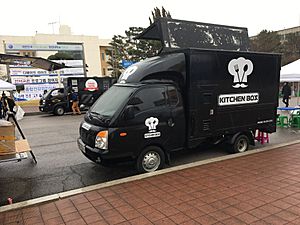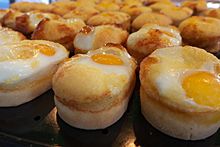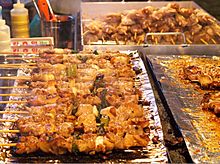Street food in South Korea facts for kids
Street food in South Korea is a big part of Korean culture. For a long time, popular street foods included Eomuk (fish cakes), Bungeo-ppang (fish-shaped buns), and Tteok-bokki (spicy rice cakes). You could find these foods in many different places.
Recently, street food has become super popular again in South Korea. A great example is the "Bamdokkaebi Night Market" (밤도깨비야시장) at Hangang Park. These food stalls are often run by older men (ahjusshi) or women (ahjumma). They are a key part of Korea's famous food scene.
Contents
A Look Back: History of Street Food
South Korea has many traditional street foods. Imagine sticky rice cakes called Chapssal-tteok, or dalgona, a sweet candy made from sugar and baking soda. There's also Bungeo-ppang, a fish-shaped bun with sweet bean paste. You might also find roasted sweet potato and Chinese pancakes with brown sugar, called Hotteok. These classic street foods are most popular in winter. In summer, ice cream is a bigger hit!
During the Joseon Dynasty (a long time ago in Korea), street vendors started selling food. This helped people with lower incomes around markets. After the Korean War, street vendors became even more important. They offered affordable meals to many people, including refugees and U.S. troops. Areas like the Cheonggyecheon Stream, Itaewon, and Jongno districts influenced street food. It quickly became a big part of South Korea's food culture.
In the 1300s, food stalls began to appear in Joseon markets. Before the 1960s, many stalls sold jinppang (steamed bread with red-bean paste) and hoppang (steamed buns with veggies or meat). These were like the first Korean street foods. They came from Japan in the early 1900s. Later, in the 1970s, foods like tteokbokki and gimbap became popular.
Street Food Today: New Trends
In the past, street food was mostly snacks like hotteok or fish cake skewers. But now, you can find bigger meals like jokbal (pigs' feet), steak cubes, and jajangmyeon (black bean noodles). Because of this, street food is sometimes called a "moving restaurant."
There have been some challenges for street vendors. People used to worry about how clean the food was. But vendors have worked hard to make things better. Also, street vendors didn't always pay taxes. Now, after getting help from the government, many vendors, like those in Noryangjin, are paying taxes.
Korean street food has become very fancy and diverse. You can find foods from all over the world! Think of Chinese Tanghuru, Kebabs, Turkish ice cream, or Chilean Churros. Your food is usually ready in just 2-3 minutes. Street foods are made to look good and taste amazing. Watching the vendors cook on a hot iron plate can be a show itself!
There are even festivals for street food, like the Night Market at Hangang Park. University festivals also often have many street food stalls. With new items like steak cubes, street food has become quite luxurious.
Different Ways to Enjoy Street Food
Food Trucks
Food trucks are a new and popular way to get street food in Korea. You can find them in parks and art areas. They offer a fresh take on eating out.
Food Bikes
Food bikes are bicycles that sell food. Some are pedal-powered, and some are motorized tricycles. This is a new idea in Korea. There are plans to test them out in Gyeonggi-Do soon.
Pojangmacha
A pojangmacha is a small tent or stall, often on wheels, that sells many kinds of street foods. You can find hotteok, gimbap, tteokbokki, sundae (Korean sausage), dakkochi (chicken skewers), odeng (fish cakes), mandu (dumplings), and anju (dishes to eat with drinks). In the evening, many pojangmacha also sell alcoholic drinks like soju. The word pojangmacha means "covered wagon" in Korean.
The number of pojangmacha in Seoul has gone down. This is because some people thought they were not clean or were operating without permits. However, many owners still keep the tradition alive. They sell classic foods like dakbal (chicken feet) and dakkochi.
Popular Street Food Hotspots
Street food used to be found only in markets or busy streets. Now, it's everywhere! Some places even have special streets just for street food.
Busan: Kkangtong Market
Kkangtong Market in Busan was the first night market in South Korea that stayed open all the time. It has many unique street foods. You can try fusion rice balls with Japanese pork and kimchi, Vietnamese fried dumplings, and mie goreng (Indonesian fried noodles).
Myeong-dong
Myeong-dong is super famous for its street food. You can find traditional foods like chicken skewers. But there are also new and exciting foods like deep-fried blue crab and grilled scallops. Many tourists who visit Myeong-dong love to eat at these stalls. About half of the 200 stalls in Myeong-dong sell food.
Hongdae
Hongdae is known as the "Mecca of Youth." It has lots of street foods that young people and tourists love. You'll find Korean favorites like tteokbokki, dakgangjeong (sweet and sour chicken), hotteok, fish cakes, bungeoppang, and rice cake skewers. You can also find international treats like churros, crepes, and takoyaki.
Noryangjin
Noryangjin's street food scene is around exit 1 of Noryangjin Subway Station (Line 1). Many street vendors gather here. It gets very busy at lunchtime with students. Recently, Noryangjin has become popular with tourists, thanks to international students sharing it on social media.
Jeonju: Hanok Village
Jeonju Hanok Village offers many street foods with a Korean twist. You can try "Bibimbap Croquet," "Bibimbap Baguette," and "Bibimbap Dumpling." These are traditional Korean foods made in new ways. You'll also find local foods made with ingredients from the Jeonbuk area.
Gwangjang Market
If you love Korean food, you must visit Seoul's Gwangjang Market. It's one of the oldest markets in South Korea, over a century old! It's a great place to experience traditional culture and try tasty foods. One of the most popular foods here is mayak gimbap. These are like sushi rolls wrapped in seaweed, filled with carrot, pickled radish, and sesame oil-seasoned rice. Other specialties include bindaetteok, a savory pancake made from mung beans, vegetables, and meat. You can also try makgeolli, a cold rice wine. Some food markets stay open late, but most close around 6 PM or 11 PM.
Namdaemun Market
Namdaemun Market started around the 1400s. It's considered Seoul's oldest and largest market, with over 10,000 different stalls! The Food Alley has many Korean dishes like steamed corn, dakkochi (chicken skewers), and jokbal (pigs' feet). Many foods here are "classics" because they have been around for a long time. Besides food, you can find jewelry, luggage, stationery, hiking gear, camera parts, and traditional handicrafts at good prices.
Seoul Bamdokkaebi Night Market
The Seoul Bamdokkaebi Night Market is known for mixing different cultures. It brings together unique foods and items. At night, the market offers food and fun activities. Most of the stalls are food trucks. They sell special foods like Cuban sandwiches, Korean-style tacos, steak in cups, and lobster rolls. It's often crowded with long lines because it's in a busy area along the Han River.
Examples of South Korean Street Foods
| Bungeoppang | This fish-shaped bun is filled with sweet red beans. It's a classic street snack that came from Japan in the 1930s. The Japanese Taiyaki became Bungeoppang in Korea. "Tai" means sea bream, and "yaki" means roasted. It was a cheap snack that copied a more expensive Japanese food. It was very common in the 1950s and 1960s, and it became popular again in the 1990s. | 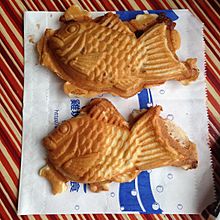 |
| Eomuk | Fish cake is made from fish meat and wheat flour. It's often served with a hot, savory soy sauce. Eomuk is also a typical Japanese food. It used to be called oden. Japanese oden includes boiled tofu, fish cake, konjac jelly, and boiled egg on a skewer. Eomuk tang (fish cake soup) came to Korea around 1876. It arrived at the port of Busan and became a popular Korean street food. Busan is famous for having the best fish cakes in Korea. | 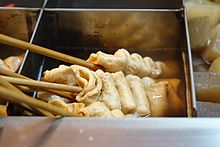 |
| Hotteok | Hotteok is a traditional Korean street food. It's usually eaten in winter. Normally, hotteok is a dough filled with raw sugar and cinnamon. Today, you can find many kinds, like hotteok with nuts (like peanuts) or green tea powder and corn flour. | 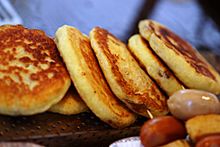 |
| Hoppang | Hoppang means steamed bun in Korean. It's made from flour, usually from the United States, and red beans. Sometimes, vegetables, meat, sweet pumpkin, curry, or pizza ingredients are added. New types of hoppang are always being created. You can find them on the street and in convenience stores. | 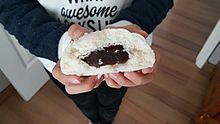 |
| Tteokbokki | Tteokbokki is stir-fried rice cake. It's a very famous Korean food. A book from 1460 called '食療纂要' mentions a food similar to tteokbokki. Before the spicy gochujang tteokbokki, there was a similar dish in the old royal court. A cookbook from the 1800s says, "I ate white rice cake with beef sirloin, soy sauce, onion, and rice cake." The spicy Kochujang (red chili paste) version became popular in the late 1960s. | 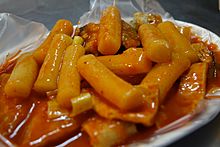 |
| Gyeran-ppang | Gyeran-ppang (egg bread) is a warm street snack sold all over South Korea. It's a fluffy, oval-shaped loaf of bread that is both sweet and savory. It has a whole egg baked inside the pancake-like dough. | |
| Dak-kkochi | Dak-kkochi, also called Korean chicken skewers, is a popular street food. It has small pieces of chicken and scallions grilled on a skewer. | |
| Galbi | Galbi means rib, and it usually comes from pork or chicken. It's a popular dish where the meat is marinated in soy sauce, garlic, sugar, and sesame seeds. It's often put on a stick for grilling and easy eating. While beef galbi can be used for soup (galbitang) or steamed galbi (galbijjim), the grilled version is the most famous. |  |
| Sundae | Sundae is a type of blood sausage. It's made with pig intestine stuffed with clear noodles, vegetables, and meat. It's usually cut into bite-sized pieces and served with pig lung and liver on the side. | 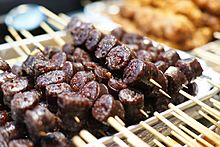 |
| Gunbam | Gunbam is a roasted chestnut. It's one of the most popular winter snacks. It's baked in a brazier and tastes both savory and sweet. | 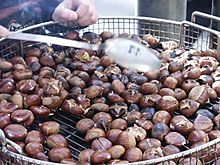 |


